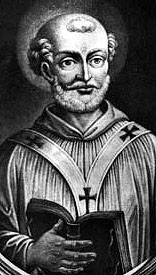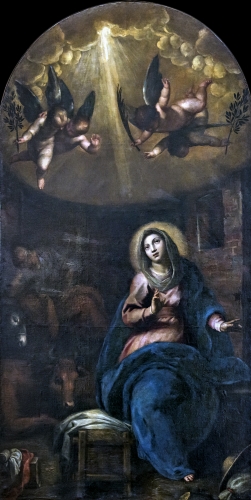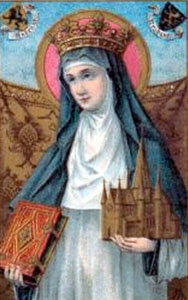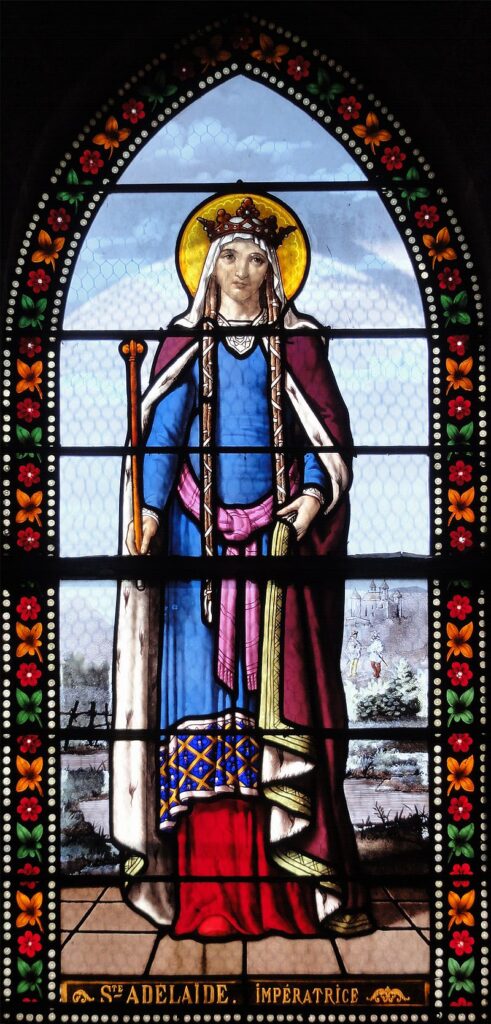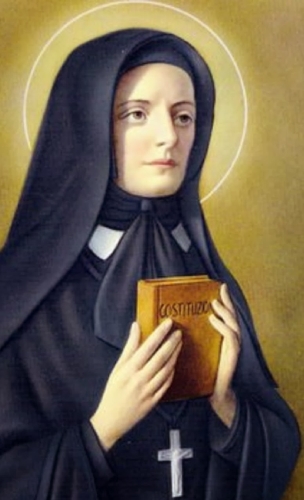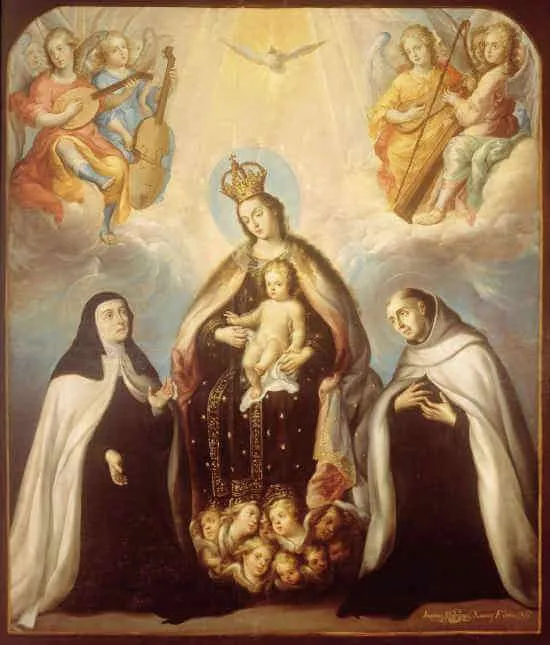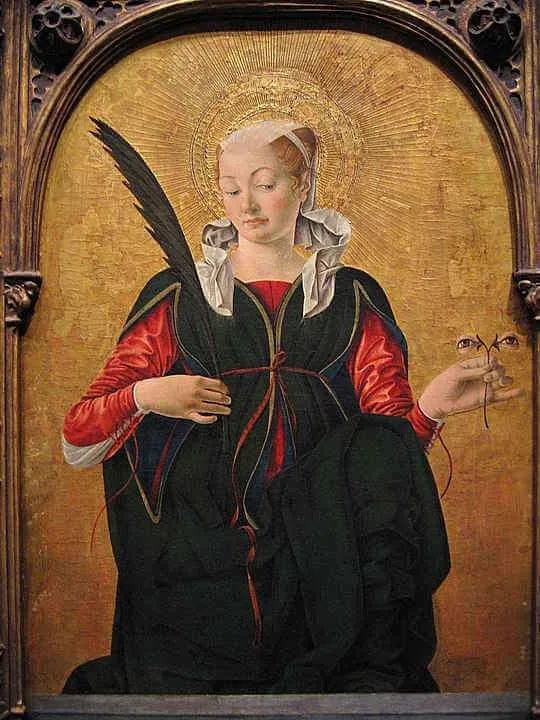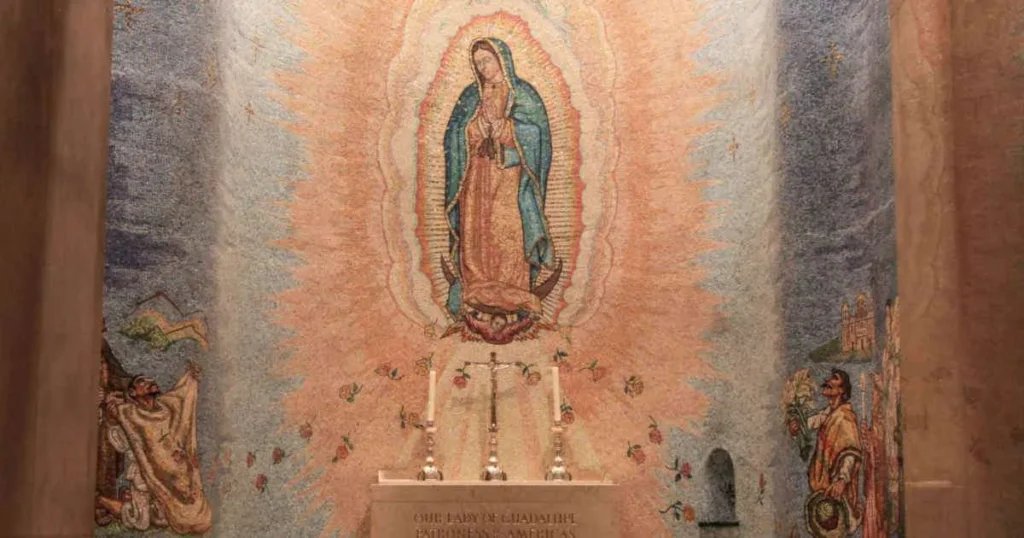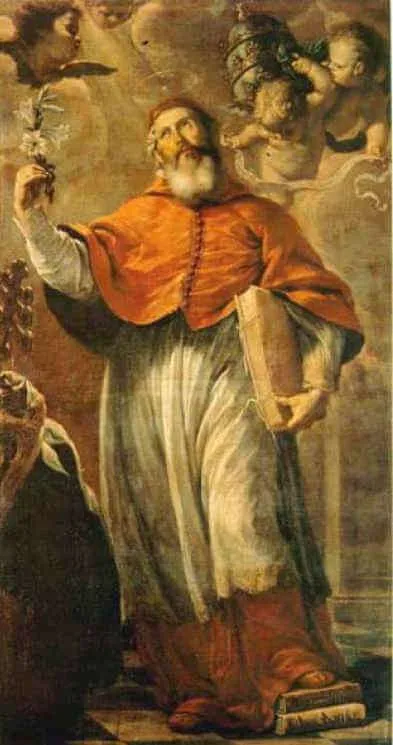Saint Anastasius I, Pope
Saint Anastasius I, Pope Read More »
Profile
All that is known of his early life is that he was considered pious as a youth, and cared nothing for material things as an adult.
As a pope, he was immediately involved in the turmoil resulting from the heretical writings of Origen. He convened a synod to condemn the works. He fought against the heresy of Donatism.
He was a friend of Saint Augustine of Hippo, Saint Jerome, and Saint Paulinus of Nola.
Born
4th century in Rome, Italy
Papal Ascension
27 November 399
Died
402 of natural causes
Canonized
Pre-Congregation
Source: https://catholicsaints.info/pope-saint-anastasius-i/
Saint Anastasius I, Pope Read More »
Article
This is a memorial to impress on the faithful the sentiments of the Blessed Virgin as the time of her delivery approached.
The feast originated in Spain. When the feast of the Annunciation (25 March) was transferred to 18 December because of the regulation forbidding feasts in Lent, it remained on this date after the Annunciation was again celebrated on its original date.
Source: https://catholicsaints.info/expectation-of-the-blessed-virgin-mary/
Expectation of the Blessed Virgin Mary Read More »
Profile
Begga was born to the nobility, the daughter of Saint Pepin of Landen, mayor of the palace, and Saint Ida of Nivelles. She was the sister of Saint Gertrude of Nivelles.
Begga was married to Ansegilius, son of Saint Arnulf of Metz. Her son, Pepin of Herstal, was the founder of the Carolingian dynasty of rulers in France, in 635.
On the death of her husband in 691 in a hunting accident, Begga took the veil, founded seven churches, and built a convent at Andenne on the Meuse River (in modern Belgium) where she spent the rest of her days as abbess.
Died
693 at Andenne on the Meuse River in modern Belgium
Canonized
Pre-Congregation
Patronage
Andenne, Belgium
Source:
Saint Begga of Andenne
https://en.wikipedia.org/wiki/Begga#/media/File:Begga_de_landen.jpg
Saint Begga of Andenne Read More »
Profile
Adelaide was born a princess, the daughter of King Rudolf II (Rupert II) of Upper Burgundy. She was promised at age two in an arranged marriage as part of a treaty between Rudolf and Hugh of Provence. She was married at age 16 to Lothair of Italy, who eventually became king of Italy.
Adelaide was widowed in 950 while still a teenager; Lothair was probably poisoned by his successor to the throne, Berengarius. As part of his attempt to solidify his grip on power, Berengarius ordered Adelaide to marry his son; she refused, and was imprisoned. She was freed soon after when the German king Otto the Great defeated Berengarius.
Adelaide married Otto in Pavia, Italy in 951. He was crowned Emperor in Rome, Italy in 952, and Adelaide reigned with him for 20 years. Widowed in 973, she was ill-treated by her step-son, Emperor Otto II and his wife Theophano, but eventually reconciled with her royal in-laws.
When Otto II died in 983, he was succeeded by his infant son, Otto III. Theophano acted as regent, and since she still did not like Adelaide, used her power to exile her from the royal court. Theophano died in 991, and Adelaide returned once again to the court to act as regent for the child emperor.
Adelaide used her position and power to help the poor, to evangelize, especially among the Slavs, and to build and restore monasteries and churches. When Otto III was old enough, Adelaide retired to the convent of Selta near Cologne, a house she had built. Though she never became a nun, she spent the rest of her days there in prayer.
Born
c. 931 in the kingdom of Burgundy, Holy Roman Empire (modern Burgundy, France)
Died
16 December 999 at the monastery of Selta (Seltz), Alsace of natural causes
Canonized
1097 by Pope Urban II
Patronage
Representation
Source/s:
Saint Adelaide of Burgundy
https://en.wikipedia.org/wiki/Adelaide_of_Italy#/media/File:Sainte-Ad%C3%A9la%C3%AFde_-_%C3%89glise_de_Toury,_vitraux_par_Lorin.jpg
Saint Adelaide of Burgundy Read More »
Profile
Mary is one of the nine children born to the industrialist Clement di Rosa and Countess Camilla Albani. Her father owned a large spinning mill, and Mary grew up in a happy and pious family. She was educated by Visitandine nuns.
Mary’s mother died when she was seventeen, and she left school to help manage her father‘s estate. Her heart set on a religious life, she turned down many suitors. She worked with young girls in her community, those who worked in her father‘s mills, and the sick in local hospital. She also work tirelessly during the cholera epidemic of 1836.
Mary founded a home dedicated to the spiritual needs of young girls, and a school for deaf children. In 1840, she became the superior of the Handmaids of Charity, nuns who cared for the sick, and she took the name Mary Crucifixa. The community received their bishop‘s approval in 1843 and papal approval in 1850. Mary led them until her death.
Born
6 November 1813 in Brescia, Italy as Paula Frances Mary di Rosa
Died
15 December 1855 in Brescia, Italy of natural causes
Venerated
10 July 1932 by Pope Pius XI (decree of heroic virtues)
Beatified
26 May 1940 by Pope Pius XII
Canonized
12 June 1954 by Pope Pius XII
Source: https://catholicsaints.info/saint-mary-di-rosa/
Saint Mary di Rosa Read More »
In 1545, when Juan was only three years old, his father died, leaving Catalina to raise and provide for their boys, a difficult responsibility for a widow at that time. She sought assistance from Gonzalo’s family but was rejected. Therefore, she and her boys lived in destitution. Two years after Gonzalo’s death, Luis died of malnutrition. Eventually, Catalina took Francisco and Juan and moved to Medina del Campo, a larger city, and resumed her work as a weaver.
In Medina, Juan was able to attend a boarding school for poor children. He received a basic education, housing, and food. Juan proved to be an excellent student and, in 1559, was invited to study at the nearby newly founded Jesuit school at the age of seventeen. With the Jesuits, Juan studied the humanities, grammar, rhetoric, Latin, and Greek. Four years later, in 1563, he entered the Carmelite Order, taking the name John of Saint Matthias.
John made his profession as a Carmelite in 1564 and subsequently received special permission from his superiors to follow the ancient Carmelite rule to the letter, rather than embrace the various changes to the rule that occurred over the years. After his professions, he was sent to study theology and philosophy at the prestigious university in Salamanca. There he excelled in his studies and was known for his intelligence and insights.
At the end of his studies, John had second thoughts about his vocation as a Carmelite, preferring instead to live a more contemplative life. As a result, he decided that he would enter the Carthusians once he was ordained. John was ordained a priest in 1567.
Father John returned to Medina to offer his first Mass. However, his intention to join the Carthusians all changed after meeting the Carmelite nun Teresa of Ávila. Mother Teresa was a reformer of the Carmelite Order and was in Medina to found a new convent. While there, she heard of the newly ordained priest, Father John, and attended his first Mass. Later, she spoke to him about her ideas on reforming the Carmelites in hopes that he would become her first friar in the reform. Father John was intrigued and accepted her invitation to remain a Carmelite and assist her with the new reforms, reviving the ancient rule.
After returning with Mother Teresa to Valladolid, he participated in a period of formation under her guidance and founded the first house for friars, along with two other Carmelite brothers. This first house began formally on November 28, 1568. Father John gave up his old name and took on the new name of Father John of the Cross. As more friars joined them, Father John, now the subprior and novice master, moved to a larger house in nearby Alcalá where he also became the rector of the university.
In May of 1572, Mother Teresa asked him to move to Ávila to become the spiritual director for the sisters at the Monastery of the Incarnation. He remained there for five years, working closely with the sisters and growing deep in his own spiritual life. He was especially blessed to act as spiritual director to Mother Teresa who, in many ways, acted as a spiritual guide to him.
Shortly after his arrival in 1572, Mother Teresa entered into the spiritual transformation of the Divine Union while Father John acted as her spiritual director. At times, their conversations led both of them into ecstasy as the Holy Spirit worked powerfully in their lives and through their spiritual friendship.
Sadly, politics had its place in the Church at that time, and there were some who did not like the idea of reforming the Carmelite order. In January of 1576, Father John was arrested for the first time by the more contemporary and well-established Carmelites of the Observance. They wanted to end the reforms of Father John and Mother Teresa and their Discalced Carmelites (meaning those who wore sandals rather than shoes).
His arrest was quickly ended by the intervention of the papal nuncio, Nicolás Ormaneto, who was favorable toward the reforms of the Discalced Carmelites. However, the following year, in June of 1577, the nuncio died. A new nuncio was appointed who was not in favor of the reforms. In December of that year, Father John was once again arrested by the Carmelites of the Observance and put in prison in their monastery in Toledo, where he remained for nine months.
After Father John’s arrest, the Provincial ordered him to “repent” of his reforms and to return to the monastery in Medina. Father John refused to do so, arguing that he was not bound by the Provincial’s demands, since he had received permission for his work on the reform from the nuncio Ormaneo while he was alive. As a result, Father John was judged as being rebellious and willfully disobedient to their authority and was imprisoned in a six-by-ten-foot dungeon cell.
During the nine months of his imprisonment, Father John was regularly abused by the friars in attempts to get him to “repent.” He was given no change of clothing, very little food, endured a severe case of lice, and had only his breviary to read. He endured the severe cold of the winter and the heat of the summer in the small dark cell that had only one small window high up on the wall.
However, it was during this time of abuse that some of the greatest spiritual treasures to fill our Church were born. Father John, in the darkness of this prison, composed numerous poems, including Dark Night of the Soul and portions of the Spiritual Canticle. God did not allow this abuse to go fruitless. Father John grew deep in the spiritual life and entered into interior freedom through his prayer and surrender to God.
In August of 1578, it is said that God miraculously enabled Father John to escape at night “in the darkness,” as his poem relates, and find refuge with Mother Teresa’s sisters in Toledo. Eventually, he escaped to Santa Cruz, where he was cared for secretly and nursed back to full health.
Over the coming years, his prison experience, the poems he composed, and his life of deep prayer and study prepared him to write four of the greatest works on mystical theology the Church has ever known: Ascent to Mount Carmel, Dark Night of the Soul, Living Flame of Love, and Spiritual Canticles. Each book was a commentary on the mystical poems he had composed. The poems themselves are considered to be among the most beautiful poems written in the Spanish language.
During the year after Father John escaped imprisonment, the Discalced Carmelites did all they could to regularize their situation within the larger Carmelite order and within the Church. Though the new nuncio tried to stop them, the king intervened. In April of 1579, a new provincial was appointed to oversee the Discalced Carmelites and to assist them with their reforms.
In 1580, the Holy See allowed the Discalced Carmelites to enjoy independence from the Carmelites of the Observance, and Father John was appointed as prior of one of the new monasteries. Mother Teresa died in 1582. In 1585, the Discalced Carmelites were given even greater independence from the Carmelites of the Observance when they were established as an independent province. Father John was elected Vicar Provincial.
The charisms of this reform in which Father John and Mother Teresa were so instrumental included the following: 1) a strong Marian devotion, 2) a daily plan carefully set forth to maintain a life of continual prayer, and 3) a strict rule of enclosure focused on the asceticism of solitude, manual labor, perpetual abstinence, fasting, and fraternal charity. Many were attracted to this new strict Carmelite life. Therefore, monasteries of both nuns and friars continued to be founded.
Father John continued to found monasteries and oversee the reform until September of 1591, when he developed gangrene on his leg. He went to a monastery in Ubeda to receive care for his illness. Instead, the superior treated him coldly, arguing that Father John was a burden to the monastery.
On December 13, just hours before his death, Father John called the prior to his cell and humbly begged his forgiveness for being a burden. This act of humility completely transformed the prior who was overwhelmed by Father John’s sanctity. At midnight, the saintly friar went home to Heaven to his Beloved to sing Matins with the angels, thus completing his mystical journey to divine union.
Saint John of the Cross endured many trials throughout his life, but God used those trials as a foundation for the spiritual formation he would provide to the Church through his masterful mystical theology. It could be argued that no one has captured the depths of the spiritual life, leading us to Divine Union and Mystical Marriage, better than Saint John of the Cross. He did not shy away from describing, in great detail, the interior purifications a soul must endure on that journey to complete freedom.
As we honor that great saint and mystical doctor of the Church, ponder the profound spiritual truth—that complete union with God is an ongoing process that requires total surrender, interior purgations of the senses and spirit, mortification, and mystical annihilation. Though these concepts are deep and utterly otherworldly, they are beautiful truths that the Church continues to uphold. Allow Saint John to inspire you to go deeper in your faith journey so that your divine union will evolve and blossom into the glorious life God desires for you.
Source: https://mycatholic.life/saints/saints-of-the-liturgical-year/14-december-saint-john-of-the-cross-priest-and-doctor–memorial/
Saint John of the Cross, Priest and Doctor Read More »
Lucy was born in Syracuse, Sicily, around the year 283 to Christian parents. When she was five, her father died, leaving her mother, Eutychia, to raise her alone. Eutychia suffered from hemorrhages and feared for Lucy’s future, so she arranged a promise of marriage for her daughter to a nobleman from a pagan family.
A half century earlier, the holy virgin Saint Agatha had been martyred forty miles north of Syracuse in the city of Cantania. Saint Agatha was revered as the glory of Cantania. Her tomb became a popular place of pilgrimage and site of many miracles. Hopeful of a cure of her mother’s hemorrhages, Lucy convinced her mother to make a pilgrimage to Saint Agatha’s tomb. Eutychia agreed.
While at the tomb, the two fervently prayed for a long time. As they did, Lucy had a dream-like vision in which Saint Agatha appeared to her, informing her that her mother would be cured because of Lucy’s faith, and that Lucy would become the glory of Syracuse, just as Agatha was the glory of Cantania. When Lucy awoke from her vision, she cried out, “O, mother, mother, you are healed!”
From that moment on, Lucy continued to sense Saint Agatha speaking to her about her calling to be a Bride of Christ and to die as a martyr. She informed her mother of her desire to remain a virgin and begged her to offer their wealth to the poor. Her mother hesitated, suggesting it would be better for Lucy to do so once Eutychia had died, but Lucy urged her to do so right away because it would be a source of much greater merit. Lucy’s faith won the day. She continued to postpone her marriage and spent the next few years joyfully distributing her money and jewels to the poor.
In the year 303, Roman Emperor Diocletian issued an edict outlawing Christianity in the Roman Empire. Christian Churches and sacred texts, such as Scripture and liturgical books, were to be destroyed. Christians were forbidden to gather for worship. Civil servants and nobility were stripped of their ranks and belongings. Christians who were discovered were forced to offer sacrifice to the Roman gods and the emperor; those who refused were tortured and even killed.
Though this was clearly a grave evil to befall those who professed their faith in Christ, it also resulted in a strengthening of faith for many. Secret worship regularly took place at the risk of the worshippers’ lives. Honored martyrs inspired the faithful to imitate the martyrs’ steadfast faith.
Around the year 304, when Lucy was around the age of twenty-one, her suitor became aware of the large sums of money that she had distributed to the poor. He was also aware that Lucy had done so on account of her Christian faith and realized that she was not going to become his bride. Enraged, he reported Lucy to Paschasius, the Governor of Syracuse, denouncing her as a Christian.
When Governor Paschasius of Syracuse learned of Lucy’s Christian faith and her charity to the poor, he had her arrested and interrogated. He attempted to force her to apostatize by offering sacrifice to the Roman gods, but she refused. A later Roman martyrology put these words into Lucy’s mouth:
“I know but one sacrifice pure and full of honor, which I can offer. This is to visit orphans and widows in their tribulation, and to keep oneself unspotted from the world. For three years, I have daily offered this sacrifice to my God and Father; and now I long for the happiness of offering myself to Him as a living victim. His holy will be done!”
Lucy then accused the governor of demon worship and prophesied his condemnation before God. The governor was outraged and ordered her to be defiled in a brothel. When the guards tried to move her, she was heavier than a boulder. They even tried to move her with a rope tied to the yoke of oxen, but she didn’t budge. The guards then surrounded her with wood to burn her, but the flames did not harm her. Finally, the governor ordered a soldier to thrust his sword into her neck, and God permitted her martyrdom to be completed. One martyrology attributes these prophetic words to her as she was dying:
“I announce to you a great joy. Diocletian descends from his throne, Maximian dies, the Church breathes again: peace extends its protecting wing over the martyred Saints. O Syracuse, O place of my birth, as Catania finds its safety and glory beneath the guardianship of my sister Agatha, so shalt thou be shielded by me, if thou art willing to embrace that Faith, for the truth of which I shed my blood.”
Saint Lucy is often depicted in sacred art holding her eyes because much later legends state that either the guards gouged her eyes out as torture, or that she gouged her own eyes out so that her suitor would no longer be tempted by their beauty.
Veneration to Saint Lucy quickly spread, and her prophetic dream-vision came true—she became the glory and protector of Syracuse and the source of many miracles. By the end of the sixth century, she was so revered throughout the Roman Empire that Pope Saint Gregory the Great inserted her name into the Roman Canon (Eucharistic Prayer I)—“…graciously grant some share and fellowship with your holy Apostles and Martyrs: with John the Baptist, Stephen, Matthias, Barnabas, Ignatius, Alexander, Marcellinus, Peter, Felicity, Perpetua, Agatha, Lucy, Agnes, Cecilia, Anastasia and all your Saints…”
The fact that a young virgin martyr would become so revered and honored for many centuries after her birth is a testimony to the power of God. Saint Lucy not only imitated her Lord, but in her humility, she reflected the glory of the Mother of God who, in her song of praise, proclaimed, “For he has looked upon his handmaid’s lowliness; behold, from now on will all ages call me blessed. The Mighty One has done great things for me, and holy is his name…” (Luke 1:49–49).
As we honor this saint who was crowned with virginity and martyrdom, ponder the courage and resolve she had to choose death over a life of nobility. She fell in love with her divine Spouse, He entered into union with her, and she turned her eyes firmly upon His holy will. Seek to imitate Saint Lucy’s courage and resolve, choosing Christ and Him alone, renouncing all that is contrary to His holy will.
Source: https://mycatholic.life/saints/saints-of-the-liturgical-year/13-december-saint-lucy-of-syracuse-virgin-and-martyr–memorial
Saint Lucy of Syracuse, Virgin and Martyr Read More »
On December 9, 1531, Juan Diego’s life was forever changed, and the Mother of God immediately strengthened the missionaries’ efforts. Juan was walking some distance to the nearby city of Tlatelolco early in the morning so he could attend daily Mass and catechism class.
As Juan passed by Tepeyac Hill, a heavenly woman appeared to him. She appeared as a mestiza woman, a mixture of Spanish and Indigenous heritage, with dark-toned skin and long black flowing hair. Behind her was an oval of beaming rays that resembled the sun. She was clothed in a rose-colored robe with a blue-green mantle, adorned with gold stars and a golden edge. On her protruding womb was a bow with a four-petal floral design that depicted abundant new life. She wore a black tassel above her womb, which was an Aztec indication of pregnancy. She was standing on a crescent moon held by an angel. Her general appearance was one of great sanctity, peace, gentleness, and high nobility.
As soon as she appeared, she spoke to Juan in his native Nahuatl language, referring to him affectionately as “Juanito, Juan Dieguito…” (My little Juan, my dear Juan Diego), and lovingly introducing herself to him as the Ever-Virgin Mary, the Mother of God. She told Juan that she wanted a church built on that very spot in her honor and instructed him to inform Bishop Zumárraga of her request. Juan did so that same day, but the bishop needed time to think about his request.
Juan then returned home by the same route and once again encountered the Mother of God at the same spot. He regretfully informed her that the bishop did not agree to her request and humbly suggested to her that she pick someone more important for the task so that the bishop would more easily agree. Smiling, the Blessed Virgin Mary informed Juan that he was her chosen one and that he should return to renew her request to the bishop.
The following morning, December 10, Juan did as the Mother of God had asked. He returned to the bishop’s residence and informed him that the Virgin Mary appeared a second time, renewing her request. This time, the bishop appeared to be more open and told Juan that if the Mother of God appeared to him a third time, he should ask her for a sign so the bishop could be certain that the request came from her.
While returning to his home, the Virgin Mary appeared to him a third time at the same spot and Juan informed her of the bishop’s request. The Mother of God agreed to meet that request and instructed him to return to her at their meeting spot the following day.
The next day Juan’s uncle, Juan Bernardino, came down with a sudden and severe illness, so Juan remained with him all day and was unable to go to meet his heavenly mother. Very early the next morning, Juan Bernardino’s condition worsened, so Juan Diego set off for the city to ask a priest to come to anoint him. Because he was in a hurry and feared being delayed by the Mother of God, Juan took an alternate route to the city, but the Mother of God appeared to him on that route.
When Juan informed her of his uncle’s illness, the Mother of God exclaimed with love, “Am I not here, I who am your mother?” She assured Juan that she had already cured his uncle, which was confirmed when Juan arrived home to his uncle who informed Juan that he, too, had experienced an apparition of the Mother of God who healed him.
In the meantime, the Mother of God asked Juan to climb a hill where he would find roses that were not in bloom that time of year. He did so, picked them, and returned to her. She rearranged the roses in his cloak (tilma) and told him to go to the bishop and show him the roses as proof for him. So Juan set off for the bishop’s residence.
After arriving, Juan remained waiting for a long time. When he was finally announced and entered the bishop’s residence, he opened his tilma and poured the roses on the ground, telling the bishop that they were the sign he asked for. As he did so, the Mother of God imprinted her image on Juan’s tilma, just as she had appeared to him. The bishop fell to his knees and venerated her. The bishop kept Juan’s tilma in his chapel until he built a chapel in compliance with the wishes of the Mother of God.
Bishop Zumárraga led an elaborate procession to the new Tepeyac Hill chapel, where he enshrined the tilma on December 26, 1531. Juan was so transformed by the experience that he successfully requested permission from the bishop to build a hut nearby and live as a hermit and guardian of the image.
From that time on, Juan’s prayer life grew deep and his virtues became continuously more pronounced. The story spread rapidly among the Aztec peoples of every tribe, and many came to venerate the holy image, while Juan Diego offered hospitality and further details that inspired many conversions.
The tilma itself is believed to be miraculous for many reasons. The cloth on which the image is imprinted is made from cactus and normally disintegrates after about fifteen years. The tilma, however, is now almost 500 years old and is in perfect condition. The image itself does not appear to have been painted by human hands. There are no brush marks, and it has remained vibrant over the years without fading.
No underlying sketch of the image can be found by modern scientific techniques. The eyes of the Virgin have been examined under magnification and reportedly reveal a reflection of the bishop on his knees along with some others nearby. In 1921, a bomb exploded next to the image in an attempt to destroy it, bending a thick medal cross on the same altar but leaving the image undamaged.
Perhaps the greatest sign of the miraculous nature of the image of Our Lady of Guadalupe is the spiritual impact that it has had upon the native people of Mexico and throughout the world. The fact that Our Lady appeared as a mixture of native and Spaniards was her way of communicating to the natives that God wanted them to be open to the message of the Gospel from the Spanish missionaries.
The bishop who built the chapel, the priests who served there, and especially the native Juan Diego himself could be trusted, and the message they had to share was heavenly. Miracles followed and conversions took place at a pace previously unseen by missionaries. Our Lady proved herself to be the greatest of evangelizers. Her appearance as a mixture of Spaniard and Indigenous also sent a message to the Spaniards that they needed to treat their new neighbors as family.
Today the Basilica in which the image of Our Lady of Guadalupe is enshrined remains one of the most sacred places of inspiration and pilgrimage in the Americas. She is patroness of the Americas and is especially revered in Mexico. As we honor this sacred apparition of the Mother of God, ponder the ongoing miracle of the 500-year-old tilma of Saint Juan Diego. To this simple and humble man, God sent His mother as a missionary; through him, the Blessed Virgin Mary’s message resonates today.
Source: https://mycatholic.life/saints/saints-of-the-liturgical-year/12-december-usa-our-lady-of-guadalupe–feast
Our Lady of Guadalupe Read More »
In 352, when Damasus was about forty-five, Liberius was chosen as the Bishop of Rome and served in that capacity for the next fourteen years. At the time of Liberius’ papal election, Damasus was an Archdeacon in Rome, serving at the Church of Saint Lawrence.
In 354, one of Constantine the Great’s sons, Emperor Constantius II, was co-emperor of the empire, along with his two brothers. Constantius II supported the Arian heresy that had been plaguing the Church for about thirty-five years, so he sent Pope Liberius into exile to a prison in Beroea for refusing to condemn Saint Athanasius, then the Archbishop of Alexandria, Egypt, for opposing Arianism.
Some records indicate that Archdeacon Damasus followed him into exile but returned to Rome shortly afterwards. At the time of Pope Liberius’ exile, Emperor Constantius II attempted to elect Felix II to the papacy. However, when the Roman citizens forced the emperor to recall Pope Liberius to Rome, Antipope Felix had to flee. Pope Liberius died in 366 in Rome.
At the death of Pope Liberius, Damasus was elected as the thirty-seventh Bishop of Rome around the age of sixty-one. Immediately, violent controversy ensued. Supporters of Antipope Felix, who had died a year earlier, rejected Damasus as pope and elected Ursicinus, another deacon in Rome. At that time, both the clergy and laity had a say in the election of their bishops. Emperors also expected the candidate-elect to be presented to him for approval.
When Pope Damasus and Antipope Ursicinus were simultaneously elected, the division became so severe that a reported 137 people were killed in the violent clashes. Eventually, the Roman civil authorities intervened and restored peace by supporting Pope Damasus and exiling Antipope Ursicinus. Pope Damasus’ enemies then accused him of murder and even adultery, but the pope rose above these calumnies.
Once Pope Damasus was securely established as the Bishop of Rome, he directed his efforts toward the governance of the Church and the preservation of orthodox doctrine. He convened synods in Rome to address heretical threats and to affirm the Nicene Creed. He remained a staunch opponent of Arianism, a heresy that persisted in various forms, despite being condemned at the First Council of Nicaea in 325. Pope Damasus was also concerned with the rising heresies of Macedonianism, which denied the full divinity of the Holy Spirit, and Apollinarianism, which denied the full humanity of Christ.
In 381, Pope Damasus appointed papal legates to represent him at the First Council of Constantinople, the second universal ecumenical council of the Catholic Church. This council not only condemned Macedonianism but also expanded the Nicene Creed to emphasize the divinity of the Holy Spirit. It also affirmed the human and divine natures of Christ, in opposition to Apollinaris’ teachings. Pope Damasus’ dedication to doctrinal orthodoxy significantly shaped the Church’s stance against these heresies and strengthened Nicene Christianity.
Perhaps one of the greatest contributions that Pope Damasus made to the Church was the commissioning of Saint Jerome to produce what is now known as the Vulgate Bible. In 382, Pope Damasus summoned the recently ordained Father Jerome from Constantinople to Rome to serve as his secretary and counselor.
Recognizing the need for a reliable Latin Bible due to the existence of many poor translations, all of which lacked cohesion, the pope commissioned Jerome to create a new Latin translation (the vernacular in the empire) from the original Greek and Hebrew sources. This new translation also had the effect of helping the Church to define which books of the Bible make up the inspired Word of God, the official canon. Jerome began this monumental task with the New Testament, translating it from Greek to Latin. Though it took him many years to complete, his translation became the standard Latin translation of the Bible and remains so today.
Pope Damasus also worked hard to improve the liturgy. He introduced the singing of psalms, helped develop the General Roman Calendar, restored churches, and commissioned sacred art. He had a great devotion to the saints (especially the martyrs), restored the catacombs in which they were buried, personally wrote poetic epitaphs for their tombs, and added special feast days in their honor.
Though today the authority of the successor of Saint Peter, the Bishop of Rome, is clearly established as being the supreme pastor of the Church, it was not so at that time. Pope Damasus was instrumental in helping to lay the theological groundwork for that doctrine as it continued to unfold for centuries, strenuously arguing that the see of the Bishop of Rome did not receive its authority from any Church council but from Jesus Himself Who said, “And so I say to you, you are Peter, and upon this rock I will build my church, and the gates of the netherworld shall not prevail against it” (Matthew 16:18).
In 380, Emperor Theodosius I, along with co-Emperors Gratian and Valentinian II, issued the Edict of Thessalonica, which declared that the Christian faith, as defined by the teachings of the Councils of Nicaea and Constantinople, was the official religion of the Roman Empire. This edict helped to further eliminate Arianism and other heresies. It is hard to predict what would have happened during that period had Pope Saint Damasus not been such a strong leader in orthodoxy.
Pope Saint Damasus lived and served during a transformative time for the Church. He was born during the worst imperial persecution of Christians but saw religious tolerance established with the Edict of Milan and saw Christianity become the official religion of the Roman Empire four years before his death.
As we honor this great saint, who had such a reverence for the saints who had gone before him, ponder the fact that our Church today professes the faith that he so vigorously fought to defend and define. His doctrinal purity, love for the liturgy, veneration for the saints, and pastoral ministry all contributed to the fruitful growth of the Church throughout Europe, and eventually to the ends of the earth. Commit yourself more fully to imitate Saint Damasus’ love for the orthodox faith so that you will share more fully in the sanctity that he now shares in Heaven.
Source: https://mycatholic.life/saints/saints-of-the-liturgical-year/11-december-saint-damasus-i-pope–optional-memorial
Saint Damasus I, Pope Read More »
Today’s memorial celebrates one of the most revered relics within the Christian world—The Holy House of Loreto. This small house, which measures 31×13 feet, rests today in Loreto, Italy, inside the Basilica of the Holy House. In the first century, the Apostles revered the Holy House when it was attached to the opening of a cave that completed the home of Jesus, Mary, and Joseph in Nazareth. It is also believed to have been the place where the Annunciation took place, making it the location where the Word became flesh within the womb of the Blessed Virgin Mary.
Some traditions also state that the Blessed Virgin Mary was born and raised in this house, but other traditions state she was born in Jerusalem and raised in the Temple. Within the house is the “Altar of the Apostles,” traditionally believed to have been built by the Apostles after the Ascension of Jesus into Heaven, with Saint Peter being the first to offer Mass there. There is also a wooden statue in the altar of the Blessed Virgin Mary holding the Christ Child. The statue of Our Lady of Loreto is a replica of the earlier statue that was destroyed in a fire in the early twentieth century.
This Holy House has a long and legendary history, the truth of which will only be known in Heaven. In the fourth century, one tradition holds that Emperor Constantine the Great, with the help of his mother Saint Helena, commissioned the building of a basilica over the Holy House in Nazareth at the same time the Church of the Holy Sepulchre was built in Jerusalem and the Church of the Nativity was built in Bethlehem. At least by the end of the fifth century, pilgrimages were made to the Holy House in Nazareth.
In the seventh century, Muslims invaded the Holy Land and destroyed the Church over the Holy House. The ruins remained until the Crusaders took back the Holy Land in the eleventh century and built a new Church over the Holy House. Muslims retook the territory of Nazareth in the late twelfth century but permitted the Franciscans to maintain the Holy House. In 1260, however, the invaders destroyed the basilica. Fighting continued until the Christian Crusaders were completely driven out in 1291.
Just prior to the Crusaders leaving the port of Acre, legend holds that on May 12, 1291, angels transferred the Holy House in Nazareth to the small town of Tersatto, modern-day Trsat, Croatia, where it remained for three and a half years. The locals were shocked at its arrival. When they entered, they saw the altar with a cedar statue of the Blessed Virgin Mary holding the Christ Child. A few days later, the Blessed Virgin Mary appeared to a priest in the Holy House, revealing to him its sacred origin. The Blessed Mother then healed the priest of an illness he had been suffering from as proof of what she had said.
The Holy House quickly became a place of pilgrimage for the locals and a much-beloved object of devotion. The legend continues that on December 10, 1294, the house was once again picked up by angels and moved to Italy. The heartbroken people of Tersatto built a replica and wrote the words, “The Holy House of the Virgin Mary came from Nazareth on May 10, 1291, and stayed here until December 10, 1294.” Today the spot is marked by the Shrine of Our Lady of Trsat and a Franciscan monastery, which make up one of the most important pilgrim sites in Croatia.
Upon the arrival of the Holy House in Italy, legend holds that it landed on a hillside overlooking the port of Ancona where it stayed for nine months. Today that spot has a shrine, and the town is called Posatora, from the Latin posat et ora, meaning “to land and pray.” The legend continues that in 1295, the Holy House moved about twenty miles south to a laurel grove near the town of Recanati. Eight months later, the Holy House was transported to a farm owned by two brothers of the Antici family, and four months later it was moved for the final time to the middle of a public road where it sits today, in modern-day Loreto, Italy. The name “Loreto,” could be derived from the Latin word lauretum, which means “place of laurels.”
Upon its final arrival, the people did not know where the house came from until the Blessed Virgin Mary appeared to a hermit, telling him the history and significance of the house. The hermit then told the townspeople, who verified the story by traveling to Tersatto and then to Nazareth. Today, the Holy House is enshrined in a marble frame; its marble exterior sits inside the large Basilica of the Holy House in Loreto.
In the year 1900, a member of the papal household is said to have discovered documents in the Vatican archives that offer a different story about the transfer of the Holy House. In 1291, just prior to the Crusaders leaving the Holy Land, a noble Byzantine family named the Angeli family paid for the removal of the relic and its transfer, probably by ship, to Croatia and then Italy. The name “Angeli,” which means “angels,” could account for the origin of the tradition that angels carried the house from Nazareth. Certainly, this is a very plausible explanation.
However, it’s interesting to note that the eighteenth century mystic, Blessed Anne Catherine Emmerich, stated, “I have often in vision witnessed the transporting of the Holy House to Loreto. For a long time, I could not believe it, and yet I continued to see it. I saw the Holy House borne over the sea by seven angels. It had no foundation, but there was under it a shining surface of light…”
Before discounting the miraculous transportation of the house, it is worth noting some scientific evidence. First, the mortar and stones used in the walls of the house come from the Nazareth area and are not found anywhere in Italy. Second, there are no cracks in the walls, indicating they were never dismantled and glued back together. Third, the size of the house matches perfectly the foundation in Nazareth from where it is believed to have come, but it would have been difficult to rebuild the house to the original dimensions. Fourth, in the thirteenth century, transporting a house, without first completely dismantling it, would have been nearly impossible. Fifth, the house landed on a public road, and the road can be seen under the foundation of the house today.
At that time, it was not permissible to build a house on a public road, so if it was reconstructed, why choose that spot? Lastly, the fact that there is such a strong tradition of devotion to the house in Croatia and also where the house initially landed in Italy suggests that the miraculous moving of the house truly took place. For these reasons, some might argue that the angelic transportation of the Holy House is actually a far more likely conclusion than the physical transportation of the house by the Crusaders at the direction of the Angeli family.
Regardless of how the Holy House arrived in Italy, it remains a place of deep devotion. Over the centuries, more than 150 canonized saints have made pilgrimages there. Many popes, kings, queens, and other royalty have visited the House, and countless others have been inspired by the story.
As we celebrate this Holy House today and honor the image of Our Lady of Loreto that resides in that house, ponder Jesus, Mary, and Joseph living there. That house should be seen as an image of our souls in which the Christ Child lives and dwells. When Christ lives within us, our homes will better reflect the environment of the home of the Holy Family. The charity and every other virtue lived within the walls of that home must also permeate our lives, families, and our entire world. Only through the prayers of the Blessed Virgin Mary and the grace of her divine Son will this be possible.
Source: https://mycatholic.life/saints/saints-of-the-liturgical-year/our-lady-of-loreto/
Our Lady of Loreto Read More »
Add San Jose Filipino Ministry as a new recipient, Send your donation using"[email protected]"
Payable to - San Jose Filipino Ministry
Address - 1235 S Magnolia Ave Anaheim, CA 92804-5115
1235 S.Magnolia Ave. Anaheim, CA 92804-5115
1235 S.Magnolia Ave. Anaheim, CA 92804-5115
Add San Jose Filipino Ministry as a new recipient, Send your donation using"[email protected]"
Payable to - San Jose Filipino Ministry
Address - 1235 S Magnolia Ave
Anaheim, CA 92804-5115
San Jose Filipino Ministry. All rights reserved. 2021 © Powered by Phoenix Virtual Solutions
Sponsored by EverClear Hospice and Palliative Care
